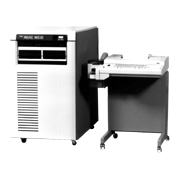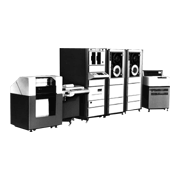In 1978, NEC announced the NEAC MS Series. It employed a revolutionary architecture for a minicomputer, with features like Japan's first directly addressable 2 megabyte (1 megaword) memory, and was developed as Japan's first true processor for distributed processing. Together with the NCOS1 operating system, which was ideal for networked online processing, this series enabled applications in the distributed processing field, as well as in the communication network control and industrial control fields.
- Distributed processing field: As a distributed processor and large terminal processor in NEC's DINA (Distributed Information-processing Network Architecture)
- Communications control field: As a front-end network processor (FNP) data collection/distribution processor, and packet switching processor etc.
- Industrial control field: As a processor for tasks such as system control, instrument analysis, machine control and process control
| MS10 | MS30 | MS50 | ||
|---|---|---|---|---|
| Announcement date | December 1978 | February 1978 | February 1978 | |
| Memory | Maximum memory capacity | 64Kword | 256Kword | 1Mword |
| Word configuration | 16 data bits + 6 ECC bits | 16 data bits + 6 ECC bits, or 16 data bits + 2 parity bits | ||
| Cycle time | 700ns | 700ns | 465ns | |
| Error correction | ECC (Automatic error detection/correction) | |||
| Memory element | IC(nMOS) | |||
| Arithmetic | Control system | Microprogram | ||
| Number of instructions | Basic 122 | Basic 124 | ||
| Arithmetic system | Binary parallel, fixed point | |||
| Floating point (Optional) | ||||
| Decimal operations (Optional) | - | |||
| Registers | 26 | |||
| Interrupt levels | 64 | |||
| Other mechanisms | Boot load mechanism | Standard | ||
| Stack/Queue processing mechanism | Standard | |||
| Scientific operation mechanism | optional | |||
| Memory protection mechanism | Standard | optional | Standard | |



